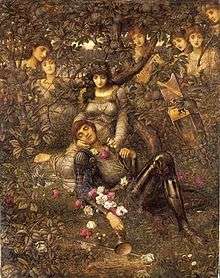John Melhuish Strudwick

(1894)

(c1888)
John Melhuish Strudwick (6 May 1849 in Clapham, London – 16 July 1937 in Hammersmith), was an English Pre-Raphaelite painter, the son of William Strudwick (1808–1861) and Sarah Melhuish (1800–1862).[1][2]
Early life
Strudwick attended St Saviour's Grammar School in Southwark. Disliking the idea of a business career, he took classes at the Royal Academy Schools in South Kensington, but was not regarded as a promising student.
Painting
In the 1860s he was encouraged by a visitor, the Scottish genre painter, John Pettie, whose style he subsequently emulated. His depiction of the ballad of 'Auld Robin Gray', which was exhibited at the Royal Society of British Artists in 1873, is an example of this period. His art style, however, developed in a new direction in the 1870s when he worked first as studio assistant to his uncle Spencer Stanhope and then to Edward Burne-Jones. In keeping with artists in his circle, he exhibited at the Grosvenor and New Galleries. Strudwick's studio was in Hammersmith, close to that of Burne-Jones and Thomas Matthews Rooke, who had also been an assistant to Burne-Jones. He married Harriet Reed and had a single daughter, Ethel (1880–1954), who later became High Mistress of St Paul's Girls' School from 1927 to 1948, and was awarded a CBE.[3][4]
His initial success as a painter came to an end when wealthy and influential patrons such as the Liverpool shipowners William Imrie and George Holt withdrew their support. His painting "When Sorrow comes in Summer Days, Roses Bloom in Vain" was left half finished in protest at the seemingly orchestrated collapse of his career.[5][6]
Style
Strudwick's paintings were done in a blend of Renaissance and medieval styles, with meticulous attention to detail, especially in his treatment of draperies and accessories, and leading to a very small output. Some thirty of his paintings depict legendary and symbolic subjects, sometimes employing a lapidary technique from the Italian quattrocento. He employed rich, deep colours, faces clearly inspired by Burne-Jones and sumptuous drapery. His work was regularly slated by Frederic George Stephens, a failed painter become critic for the Athenaeum, who could find little positive to say.
Death
The Times obituary described him as 'a beautiful old man... (and) a charming personality, exceedingly kind to young artists'.
Notable works
One of Strudwick's works, "Thy Music, faintly falling, dies away, Thy dear eyes dream that Love will live for aye" has in recent times had two celebrated owners - writer and broadcaster Sir Tim Rice in the 1970s, and in 1987, P.C. Withers of Reading, a leading authority on Strudwick. It was originally bought from the artist by the shipowner William Imrie of 'Holmstead', Mossley Hill in Liverpool. The picture's title is from a couplet by G.F. Bodley (1827–1907), the eminent architect who was closely associated with the later Pre-Raphaelite movement. Another painting, "The Gentle Music of a Bygone Day", sold for £276,500 at a Christie's auction in 1993.[7]
References
| Wikimedia Commons has media related to John Melhuish Strudwick. |
- ↑ "SARAH MELHUISH, b: 1800 - ENG". Strudwicke.com. Retrieved 2012-08-20.
- ↑ "Artists: Strudwick John Melhuish". Geometry.Net. Retrieved 2012-08-20.
- ↑ "John Melhuish Strudwick (1849-1935)". Myweb.tiscali.co.uk. Retrieved 2012-08-20.
- ↑ Hermes (2010-09-28). "Pre Raphaelite Art: John Melhuish Strudwick - 'Thy Music, faintly falling, dies away". Preraphaelitepaintings.blogspot.com. Retrieved 2012-08-20.
- ↑ "John Melhuish Strudwick | Biography and Image Gallery at ArtMagick". Artmagick.com. Retrieved 2012-08-20.
- ↑ "John Melhuish Strudwick, 1849-1937: An Overview". Victorianweb.org. Retrieved 2012-08-20.
- ↑ "John Melhuish Strudwick (1849-1937) | Christie's". Christies.com. Retrieved 2012-08-20.